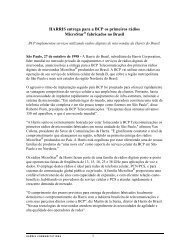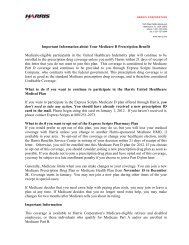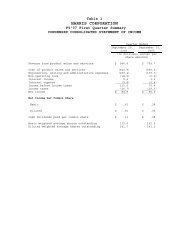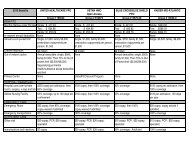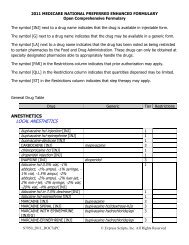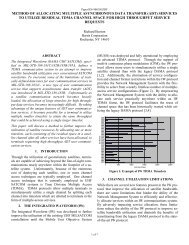harris corporation
harris corporation
harris corporation
Create successful ePaper yourself
Turn your PDF publications into a flip-book with our unique Google optimized e-Paper software.
Competition<br />
We operate in highly competitive markets that are sensitive to technological advances. Although successful<br />
product and systems development is not necessarily dependent on substantial financial resources, many of our<br />
competitors in each of our businesses are larger than we are and can maintain higher levels of expenditures for<br />
research and development. In each of our businesses we concentrate on the market opportunities that our<br />
management believes are compatible with our resources, overall technological capabilities and objectives. Principal<br />
competitive factors in these businesses are product quality and reliability; technological capabilities; service; past<br />
performance; ability to develop and implement complex, integrated solutions; ability to meet delivery schedules; the<br />
effectiveness of third-party sales channels in international markets; and cost-effectiveness. Within the IT services<br />
market, there is intense competition among many companies. The ability to compete in the IT services market<br />
depends on a number of factors, including the capability to deploy skilled professionals at competitive prices across<br />
the diverse spectrum of the IT services market.<br />
In the RF Communications segment, principal competitors include European Aeronautic Defence and Space<br />
Company N.V. (“EADS”), General Dynamics, ITT Industries, Motorola Solutions, Raytheon, Rohde & Schwarz,<br />
Tadiran and Thales.<br />
In the Integrated Network Solutions segment, principal competitors include Avid, Computer Sciences<br />
Corporation, Evertz, EVS Corporation, General Dynamics, Globecomm, Harmonic, Hewlett Packard, Lockheed<br />
Martin, ManTech, Miranda, MTN, NCI Information Systems, NEC, Northrop Grumman, Omnibus, Raytheon,<br />
RigNet, Rohde & Schwarz, Sony Broadcast, Stratos, TCS, Technicolor, Tektronix/Danaher, Telos Corporation,<br />
Thomson, and Vizada, as well as other smaller companies and divisions of large companies.<br />
In the Government Communications Systems segment, principal competitors include BAE Systems, Boeing,<br />
General Dynamics, L-3 Communications, Lockheed Martin, Northrop Grumman, Raytheon and Rockwell Collins.<br />
We frequently “partner” or are involved in subcontracting and teaming relationships with companies that are, from<br />
time to time, competitors on other programs.<br />
Principal Customers; Government Contracts<br />
Sales to U.S. Government customers, including the DoD and intelligence and civilian agencies, as well as<br />
foreign military sales through the U.S. Government, whether directly or through prime contractors, were 72 percent<br />
of our total revenue in fiscal 2011 compared with 75 percent in fiscal 2010 and 74 percent in fiscal 2009. No other<br />
customer accounted for more than 1 percent of our total revenue in fiscal 2011. Additional information regarding<br />
customers for each of our segments is provided under “Item 1. Business — Description of Business by Segment” of<br />
this Report. Our U.S. Government sales are predominantly derived from contracts with agencies of, and prime<br />
contractors to, the U.S. Government. Most of the sales of our Government Communications Systems segment and of<br />
the portions of our Integrated Networks Solutions segment’s IT services, managed satellite and terrestrial<br />
communications solutions and healthcare solutions operations in connection with U.S. Government programs are<br />
made directly or indirectly to the U.S. Government under contracts or subcontracts containing standard government<br />
contract clauses providing for redetermination of profits, if applicable, and for termination for the convenience of<br />
the U.S. Government or for default based upon performance.<br />
Our U.S. Government contracts and subcontracts include both cost-reimbursable and fixed-price contracts.<br />
Governmentwide Acquisition Contracts (“GWACs”) and IDIQ contracts, which can include task orders for each<br />
contract type, require us to compete both for the initial contract and then for individual task or delivery orders under<br />
such contracts.<br />
Our U.S. Government cost-reimbursable contracts provide for the reimbursement of allowable costs plus the<br />
payment of a fee. Our U.S. Government cost-reimbursable contracts fall into three basic types: (i) cost-plus fixed-fee<br />
contracts, which provide for the payment of a fixed fee irrespective of the final cost of performance; (ii) cost-plus<br />
incentive-fee contracts, which provide for increases or decreases in the fee, within specified limits, based upon<br />
actual results compared with contractual targets relating to factors such as cost, performance and delivery schedule;<br />
and (iii) cost-plus award-fee contracts, which provide for the payment of an award fee determined at the discretion<br />
of the customer based upon the performance of the contractor against pre-established performance criteria. Under<br />
our U.S. Government cost-reimbursable contracts, we are reimbursed periodically for allowable costs and are paid a<br />
portion of the fee based on contract progress. Some overhead costs have been made partially or wholly unallowable<br />
for reimbursement by statute or regulation. Examples are certain merger and acquisition costs, lobbying costs,<br />
charitable contributions and certain litigation defense costs.<br />
Our U.S. Government fixed-price contracts are either firm fixed-price contracts or fixed-price incentive<br />
contracts. Under our U.S. Government firm fixed-price contracts, we agree to perform a specific scope of work for a<br />
14




